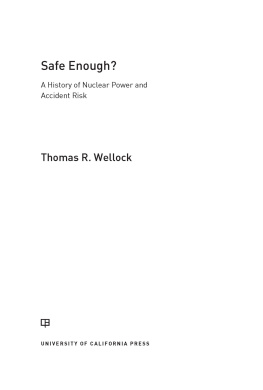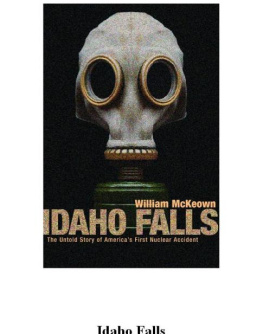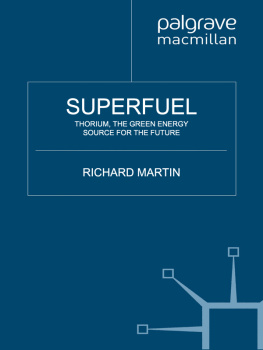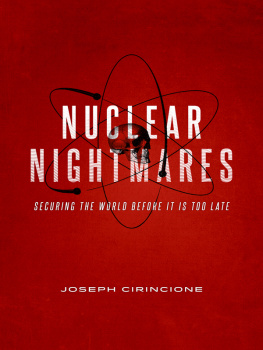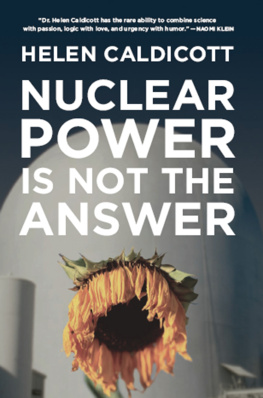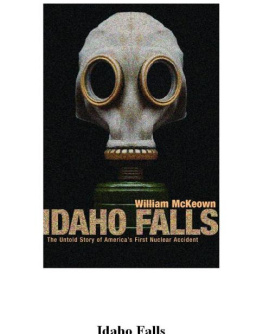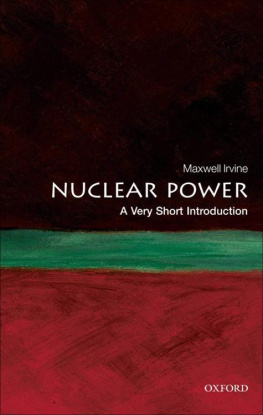Thomas R. Wellock
Published in 2021 by University of California Press in association with the US Nuclear Regulatory Commission (NRC).
Cataloging-in-Publication Data is on file at the Library of Congress.
ISBN 9780520381155 (cloth : alk. paper)
Acknowledgments
My career has spanned stints as a submarine reactor test engineer, an engineer at a commercial nuclear power plant, and fifteen years as a history professor. In the latter role, I wrote two books on the history of the antinuclear and environmental movements. It has been a privilege to serve an agency, the Nuclear Regulatory Commission (NRC), welcoming of my eclectic life experiences and committed to independent historical research. As such, this book reflects my experiences, views, and judgments alone. It is a product of my training as a historian. It does not represent in any way an official position of the NRC. I enjoyed complete independence in selecting this topic, as well as in researching and writing it. The NRC only expects that I meet the high standards of the history profession.
I am indebted to the advice and assistance of many people. Colleagues at the NRC, some now retired, read parts of the manuscript or simply offered useful perspectives, including Andy Bates, Gary Holahan, Nathan Siu, Don Marksberry, Cynthia Jones, Allen Hiser, Karen Henderson, Jack Ramsey, Jenny Weil, and Scott Morris. I am grateful to the generations of regulatory staff who eased my pursuit of history by being historians themselves. They kept an astonishing array of records and wrote their policy papers and technical reports with painstakingly chronicled background sections, a breadcrumb trail I could not have done without.
My colleagues in the Office of the Secretary have been a daily source of reinforcement, especially Rochelle Bavol, Rich Laufer, and Annette Vietti-Cook, the most supportive boss I could ask for. Kristy Remsburg has the heart of an archivist. Like the monks of medieval Ireland, she believes deeply in preserving records and never failed to help me find them. In the Office of Public Affairs, Ivonne Couret, Holly Harrington, and Eliot Brenner took me on as a special project, believing that if the NRC historian was going to communicate with the public, he ought to get better at it. They helped me write simply, develop video presentations, and do a credible job reading a teleprompter. Bebe Rhodes, Lee Wittenstein, Anne Goel, Zuberi Sardar, and Kathleen Dunsavage of the NRC technical library supported my numerous interlibrary loan requests and renewed my very overdue books without complaint. Woody Machalek and Eddie Colon guided me through the federal contracting system.
The NRC retiree community was a constant source of wisdom. Most of all, Sam Walker, my predecessor, was a source of inspiration and encouragement, and a careful reader of the manuscript. Tom Murley, a deep thinker and valuable resource, deserves special thanks. Others include Ashok Thadani, Frank Miraglia, Dennis Rathbun, and Roger Mattson. I am grateful to several who have since passed away, including Manning Muntzing, Marc Rowden, Norm Lauben, John Austin, William O. Doub, and Harold Denton.
At the University of California Press, Senior Editor Niels Hooper was enormously supportive. He and Robin Manley went the extra distance in getting the book into production. Steven Jenkins at the UC Press Foundation gamely navigated the complexities of the federal contracting system. I would also like to thank copyeditor Catherine Osborne and production editors Emilia Thiuri and Francisco Reinking.
This book is the sixth in a series of volumes on the history of nuclear regulation sponsored by the US Nuclear Regulatory Commission and published by the University of California Press. The first volume, Controlling the Atom: The Beginnings of Nuclear Regulation, 19461962 (1984), was coauthored by George T. Mazuzan and J. Samuel Walker. Walker was the author of the next four volumes, Containing the Atom: Nuclear Regulation in a Changing Environment, 19631971 (1992); Permissible Dose: A History of Radiation Protection in the Twentieth Century (2000); Three Mile Island: A Nuclear Crisis in Historical Perspective (2004); and The Road to Yucca Mountain: The Development of Radioactive Waste Policy in the United States (2009). Portions of chapters 1, 2, 3, and 6 of this book were previously published in Nuclear Technology, Technology and Culture, and History and Technology .
Preface
In 1965, the bandwagon market for nuclear power finally took off. After a decade of struggle, there was a rush of orders for reactor plants that did not abate for eight years. For the nuclear industry and the US Atomic Energy Commission (AEC), these were hectic but rewarding times. By the late 1960s, utility companies contracted for power reactors at a rate of about two dozen a year. In the early 1970s, the orders for gigantic thousand-megawatt units doubled. Nuclear power was projected to take the lions share of new orders from coal plantsabout 150 thousand-megawatt plants by 1980 and more than five hundred by 1990. The AECs regulatory division had a bumpy road to developing a licensing process amid a flood of construction permit applications. Each application raised new safety questions, but by the late 1960s, permits started to roll out with regularity, and the shortage of regulatory staff was the good kind of problem that came with a flourishing industry.
Still, supporters of nuclear power were nervous. More plants meant more local opponents. In 1970, residents of Eugene, Oregon voted to place a moratorium on its municipal electric utilitys nuclear power projects. National antinuclear organizations formed. Press coverage of the industry turned critical. Even typically apolitical magazines, such as Life and Sports Illustrated, put out exposs. There were brisk sales of books claiming the nation was playing nuclear roulette. AEC officials rushed from one controversy to another. Seismic hazards gave way to opposition to urban reactor sites, then thermal pollution drew unexpected criticism,
The usual assurances of reactor safety by AEC officials stopped working. Public opinion was supportive of nuclear power, but the opposition was scoring points. Despite a substantial counteroffensive of educational material, radio spots, film presentations, and open debates with opponents, an aide to Seaborg concluded that the AEC is in deep trouble with the public. The atoms advocates dismissed their critics as kooks and professional stirrer-uppers who spread misinformation, half-truths, and hearsay, but the new crop of opponents was smart and articulate. After one sponsored debate between AEC officials and critics, commissioner Theos Thompson called the AECs performance an utter disaster. In another debate, audiences openly rooted for the critics, who scored what one industry weekly called a technical knockout. Reassurances that a major accident was extremely unlikely fell flat.

